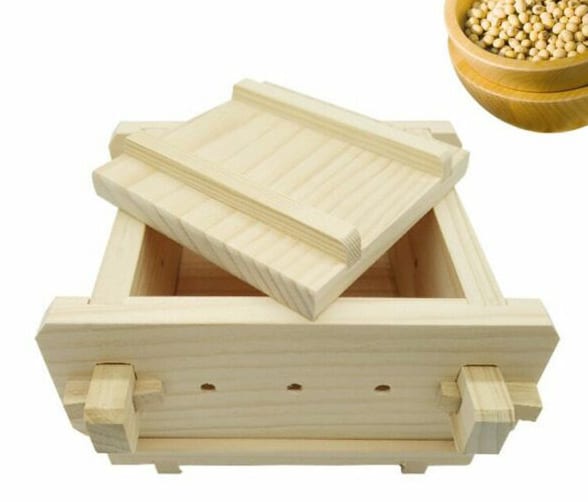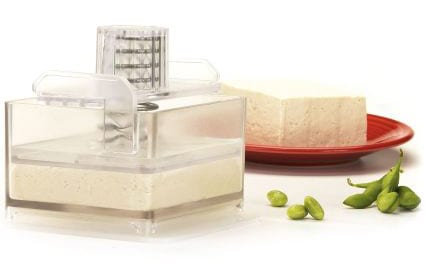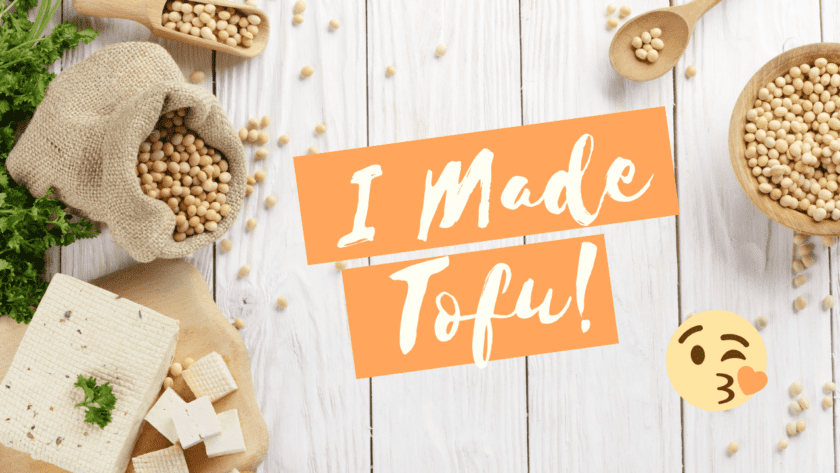As a ‘tofutarian’, I challenged myself to making my own tofu. I felt it was my duty. 😀 There are lots of recipes on the Internet, but this one is the most authentic (Japan style). It involves making your own soy milk from organic soybeans instead of starting with a commercial soy milk.
RECIPE INSPIRATION
A big shout-out to Sahy Lalime for her tofu making video on YouTube from the experts in Nagoya, Japan!
SUPPLIES YOU NEED…
- Container for rinsing / soaking beans
- Blender
- Butter muslin or nut milk bag (a tight weave is preferable, as twisting the top tightly enables you to continue squeezing out more milk)
- Heavy-bottom pan
- Instant-read thermometer (not a meat thermometer)
WHAT’S IN IT…
- 1-1/2 cups organic dried soybeans
- 4 tablespoons liquid nigari (magnesium chloride) or 1 tablespoon nigari flakes + 1/4 cup water
- Water
*Nigari is the traditional Japanese ingredient used to coagulate soymilk to make tofu.
HOW IT’S MADE…
Measure out 1 1/2 cups of beans. Rinse beans and remove any bad beans.
Soak the beans in 6 cups of water for 15 hours, uncovered (1 cup dry beans to 4 cups water.)
Add fresh water periodically.
Split a bean open to check readiness. If it’s uniform in color, it’s ready. If it’s discolored or there’s a white line going through it, then soak the beans a little longer.
Discard water and rinse soybeans in fresh water, then strain.
Put beans in a blender and add about 4 cups of fresh HOT water. Blend until the beans become smooth, but the consistency will be sandy (gritty).
Pour blended beans into a cheesecloth-lined container to separate the soybean material from the milk. I use a pitcher. (Warning: they’ll be hot from the hot water.)
Strain/squeeze the blended mixture into a bowl using damp butter muslin or a nut milk bag.
Squeeze out the liquid and soy milk (tonyu) is born!
The gritty soy pulp (okara) remains. Set the okara aside. It can be cooked with soy sauce, mirin, sliced carrots, burdock root, and shiitake mushrooms and can also be used in veggie burgers. In Japan, okara is used to make ice cream! Okara is high in nutritional value — protein, fiber, calcium, B vitamins, and isoflavones (antioxidant).
NOTE: Some people start making their tofu at this point using commercial soy milk. Eden Soy, West Soy, and 365 Whole Foods soy milk contain only soybeans and water (no other additives). The other additives can affect the final product.
Mix the water with the nigari, but don’t let it set too long!
Boil the soy milk to 212ºF (100ºC) for 5 minutes, stirring constantly or your milk will stick to the bottom of the pan and burn. Test with the thermometer.
Lower the heat to let the milk cool slightly to 160-175ºF (70-80ºC). Continue to stir.
When the milk has cooled to 160-175ºF (test with the thermometer), stir 10 times, then stir 1 time forward and back.
Add nigiri, then stir 5 times. Do not stir more than that! If you mix too much, the tofu will fall apart and will not coagulate.
Cover it! Absolutely no peeking.
Wait for 10-15 min. Keep the lid on and allow the mixture to sit undisturbed. While it sits, small white curds will separate from the light amber-colored liquid.
Now for the reveal…. Uncover and you have tofu! This is called yose-dofu (unmolded tofu). If firms up, you don’t have to mold it. Eat it right out of the pot.
For momen-dofu (firm tofu): If you want a firmer, molded tofu or your tofu is too watery (meaning you stirred too much after adding nigiri), scoop it into a traditional wood box (lined with straining cloth) and add a light weight on top to drain the excess water.


I use the TofuXpress® Gourmet Tofu Press instead, but I just press it by hand (without the heavy spring-loaded lid) as the tofu is too delicate to handle that much pressure.
Press tofu and leave it in the refrigerator for 30-40 min until it holds together.
Enjoy the fresh taste of homemade tofu! Yum!
![]() Karen’s Fit Tip: If you don’t plan to eat the tofu the same day you make it, store it in a container filled with cold water in the refrigerator. Change this water DAILY until you finish eating your fresh tofu.
Karen’s Fit Tip: If you don’t plan to eat the tofu the same day you make it, store it in a container filled with cold water in the refrigerator. Change this water DAILY until you finish eating your fresh tofu.
xo


